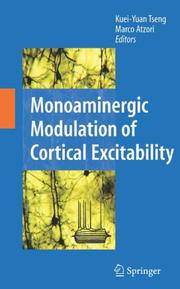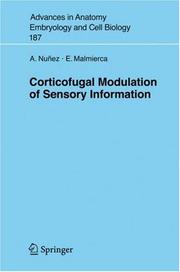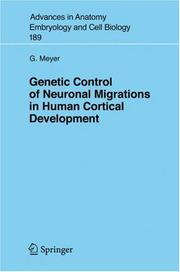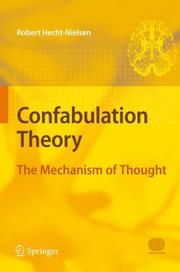| Listing 1 - 4 of 4 |
Sort by
|

ISBN: 1281044520 9786611044527 0387722564 0387722548 1441944281 Year: 2007 Publisher: New York : Springer,
Abstract | Keywords | Export | Availability | Bookmark
 Loading...
Loading...Choose an application
- Reference Manager
- EndNote
- RefWorks (Direct export to RefWorks)
Monoaminergic Modulation of Cortical Excitability serves as an integrative and comprehensive comparison of the diverse and complex modulatory action of dopamine, noradrenaline, and serotonin receptors in the cortex. The volume is organized into several sections offering a broad spectrum of opinions on how the monoamine systems affect cortical function from a cellular/sub-cellular level to a system level. The complexity of these interactions are discussed in light of recent data showing how disruption of these systems dramatically affects the memory formation and information processing in the cortex. About the Editors: Dr. Kuei Y. Tseng is Assistant Professor in the Department of Cellular and Molecular Pharmacology at Rosalind Franklin University of Medicine and Science, The Chicago Medical School, North Chicago, IL, USA. Dr. Marco Atzori is Assistant Professor at the School for Behavioral and Brain Sciences at the University of Texas, Dallas, TX, USA.
Neurochemistry. --- Amines. --- Cerebral cortex --- Effect of drugs on. --- Brain mantle --- Cortex, Cerebral --- Cortex cerebri --- Mantle of brain --- Pallium (Brain) --- Telencephalon --- Organic compounds --- Deamination --- Biochemistry --- Neurosciences --- Neurosciences. --- Neurobiology. --- Neurology. --- Medicine --- Nervous system --- Neuropsychiatry --- Neural sciences --- Neurological sciences --- Neuroscience --- Medical sciences --- Diseases --- Neurology .

ISBN: 1280863978 9786610863976 3540367713 3540367691 Year: 2007 Publisher: Berlin : Springer,
Abstract | Keywords | Export | Availability | Bookmark
 Loading...
Loading...Choose an application
- Reference Manager
- EndNote
- RefWorks (Direct export to RefWorks)
(will follow).
Cerebral cortex. --- Central nervous system. --- Sensory receptors. --- Afferent pathways. --- Nervous system, Central --- Nervous system --- Brain mantle --- Cortex, Cerebral --- Cortex cerebri --- Mantle of brain --- Pallium (Brain) --- Telencephalon --- Receptors, Sensory --- Neural receptors --- Ascending tracts --- Pathways, Afferent --- Sensory motor system --- Sensory tracts --- Central nervous system --- Neurosciences. --- Neural sciences --- Neurological sciences --- Neuroscience --- Medical sciences

ISBN: 1280803975 9786610803972 354036689X 3540366881 Year: 2007 Publisher: Berlin ; [Great Britain] : Springer,
Abstract | Keywords | Export | Availability | Bookmark
 Loading...
Loading...Choose an application
- Reference Manager
- EndNote
- RefWorks (Direct export to RefWorks)
1 Introduction Cortical development is a complex, tightly regulated process that eventually leads to the six-layered adult human neocortex, the substrate of the unique cognitive, emotional, and social abilities of our species. The basic mechanisms of early cortical development are believed to be very similar among mammals, which has led to a tendency of extrapolating experimental data from rodents on humans. Certain traits, such as the general pattern of forebrain regionalization and expression of region-speci?c genes, seem to be conserved among vertebrates (e. g. , Kammermeier and Reichert 2001; Puelles et al. 2000; Smith Fernandez et al. 1998; Abu-Kahlil et al. 2004). Furthermore, the idea of a basic uniformity of neocortical structure in all mammals, proposed by Rockel et al. (1980), has found wide acceptance. One of the recurrent themes of this monograph deals with exactly these questions: How similar are the developmental processes in lower mammals and in primates, in particular, in humans? Are there peculiarities in human cortical development which do not exist, or are not easily recognizable, in rodents? One of the most noticeable changes during evolution has been the dramatic increase in brain size, linked to the capacity to generate more neurons. The p- longed period of neurogenesis in anthropoid primates and humans makes possible a higher number of mitotic cycles, so that each dividing progenitor cell undergoes more rounds of cell divisions (Kornack and Rakic 1998). In mice, cortical p- genitors undergo 11 rounds of cell division (Takahashi et al.
Cerebral cortex --- Developmental neurobiology. --- Genetic regulation. --- Growth. --- Medicine. --- Human genetics. --- Neurosciences. --- Biomedicine. --- Human Genetics. --- Neural sciences --- Neurological sciences --- Neuroscience --- Medical sciences --- Nervous system --- Genetics --- Heredity, Human --- Human biology --- Physical anthropology --- Clinical sciences --- Medical profession --- Life sciences --- Pathology --- Physicians --- Gene expression --- Gene expression regulation --- Gene regulation --- Biosynthesis --- Cellular control mechanisms --- Molecular genetics --- Developmental neurology --- Neurogenesis --- Developmental biology --- Embryology --- Neurobiology --- Neuroplasticity --- Brain mantle --- Cortex, Cerebral --- Cortex cerebri --- Mantle of brain --- Pallium (Brain) --- Telencephalon --- Regulation --- Evolution

ISBN: 9783540496038 3540496033 9783540496052 9786610944323 1280944323 354049605X Year: 2007 Publisher: Berlin, Heidelberg : Springer Berlin Heidelberg : Imprint: Springer,
Abstract | Keywords | Export | Availability | Bookmark
 Loading...
Loading...Choose an application
- Reference Manager
- EndNote
- RefWorks (Direct export to RefWorks)
Confabulation theory offers the first complete detailed explanation of the mechanism of cognition, i.e., thinking, an essential information processing capability of all enbrained Earth animals (bees, octopi, trout, ravens, humans, et al.). Concentrating on the human case, this book offers an hypothesis for the neuronal implementation of cognition, and explores the mathematics and methods of application of its mechanism. Thinking turns out to be starkly alien in comparison with all known technological approaches to information processing. While probably not yet scientifically testable, confabulation theory seems consistent with the facts of neuroscience. Beyond science, any complete detailed explanation of cognition can be investigated by applying it technologically. Multiple experiments of this nature are described in this book in complete detail. The results suggest that confabulation theory can provide the universal platform for building intelligent machines. In short, this book explains how thinking works and establishes the foundation for building machines that think. Because of the theory’s implications for philosophy, education, medicine, anthropology and social science, this book will also be of interest to scientists in those domains.
Cerebral cortex. --- Thought and thinking --- Cortex cérébral --- Physiological aspects. --- Thought and thinking -- Physiological aspects. --- Cerebral cortex --- Models, Theoretical --- Cognition --- Investigative Techniques --- Mental Processes --- Psychological Phenomena and Processes --- Analytical, Diagnostic and Therapeutic Techniques and Equipment --- Psychiatry and Psychology --- Neuroscience --- Human Anatomy & Physiology --- Health & Biological Sciences --- Physiological aspects --- Mind --- Thinking --- Thoughts --- Brain mantle --- Cortex, Cerebral --- Cortex cerebri --- Mantle of brain --- Pallium (Brain) --- Computer science. --- Neurosciences. --- Computers. --- Artificial intelligence. --- Computational linguistics. --- Popular works. --- Cognitive psychology. --- Computer Science. --- Artificial Intelligence (incl. Robotics). --- Cognitive Psychology. --- Computational Linguistics. --- Popular Science, general. --- Theory of Computation. --- Telencephalon --- Educational psychology --- Philosophy --- Psychology --- Intellect --- Logic --- Perception --- Psycholinguistics --- Self --- Consciousness. --- Science (General). --- Information theory. --- Artificial Intelligence. --- Communication theory --- Communication --- Cybernetics --- Automatic language processing --- Language and languages --- Language data processing --- Linguistics --- Natural language processing (Linguistics) --- Applied linguistics --- Cross-language information retrieval --- Mathematical linguistics --- Multilingual computing --- Apperception --- Mind and body --- Spirit --- Neural sciences --- Neurological sciences --- Medical sciences --- Nervous system --- AI (Artificial intelligence) --- Artificial thinking --- Electronic brains --- Intellectronics --- Intelligence, Artificial --- Intelligent machines --- Machine intelligence --- Thinking, Artificial --- Bionics --- Cognitive science --- Digital computer simulation --- Electronic data processing --- Logic machines --- Machine theory --- Self-organizing systems --- Simulation methods --- Fifth generation computers --- Neural computers --- Data processing --- Automatic computers --- Automatic data processors --- Computer hardware --- Computing machines (Computers) --- Electronic calculating-machines --- Electronic computers --- Hardware, Computer --- Computer systems --- Calculators --- Cyberspace --- Psychology, Cognitive
| Listing 1 - 4 of 4 |
Sort by
|

 Search
Search Feedback
Feedback About UniCat
About UniCat  Help
Help News
News